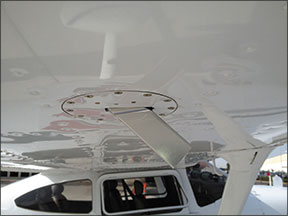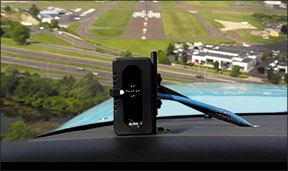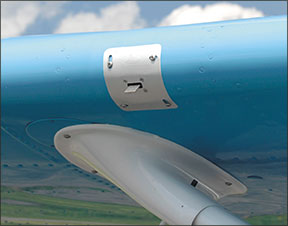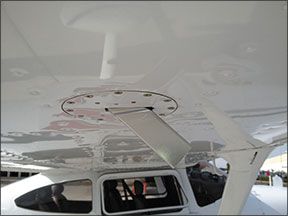For years the FAA snubbed its nose at angle of attack system retrofits for certified light aircraft. A handful of owners got lucky when the shop was able to sneak field approval paperwork through the FSDO, while others ran into a regulatory roadblock when field inspectors deemed AOA retrofits too major of a modification to approve. The expensive and time-consuming chase for additional supporting data often put an end to the project. That’s changing.

Under a new policy, manufacturers must build the systems according to standards from the American Society for Testing and Materials (ASTM) and apply for FAA approval for the design via a letter certifying that the equipment meets ASTM F3011 standards. That makes it easier for shops to win installation approval and easier yet for manufacturers to market a new breed of AOA systems to an industry that’s recognized the AoA indicator as a useful tool for avoiding aerodynamic stalls.
AOA 101
In case you were absent on the first day of private pilot ground school, angle of attack is the acute angle between the chord line of the airfoil and the direction of the relative wind. Exceed the critical angle of attack and the airfoil stalls. The key is to know how much remaining lift is available to keep the airfoil flying. That’s where angle of attack and lift reserve systems come in. But there are differences among them.
A lift reserve computer uses the difference in pressure measured between two ports on a pitot probe that is calibrated and used to determine the lift reserve. The trouble with that is the pressure differential may change with density altitude, flap configuration, G-loading and even with changes in aircraft weight. This means the system may be calibrated (a critical step in the installation process) during conditions that won’t always remain constant.
Normalized angle of attack systems, on the other hand, are designed to provide consistent AoA indications that are not related to atmospheric conditions and the aircraft configuration, including loading.
Bendix king KLR10
Made for Bendix King by Alpha Systems, the KLR10 lift reserve system references an air pressure probe that mounts on an existing inspection plate on the underside of the wing.
Installation is straightforward as long as the probe is installed outside of the propeller arc, in undisturbed air and placed between 10 to 90 percent of the wing’s main aerodynamic chord.
The probe connects to an interface module that serializes the differential pressure and then sends the data to a glareshield-mounted AoA indicator. The indicator is available with an optional swivel mount so you can mount it to a curved glareshield or adjust it for more precise positioning within your primary field of vision.
The system can be connected to the aircraft audio panel for audible voice alerts. As the system senses angle of attack, the first warning is to “check AOA,” with a red caution alert on the display. An increasing angle of attack triggers a “caution, too slow” callout, while the display flashes red. As the wing enters an aerodynamic stall, the voice alert calls “too slow, too slow,” while the display flashes a down arrow prompting you to push the nose down.
Calibrating the system is critical to performanc. There are three main reference calibrations that need to be performed after installation, including one at zero airspeed, one at cruise alpha and another at a high angle of attack.
Alpha systems
Alpha Systems is the clear leader when it comes to the variety of available display options. As noted in the Bendix King KLR10 section, the system uses an inspection plate-mounted pressure probe (available in a heated version) and a remote serializer. The company recently added a HUD (heads up display) adapter for use with its rectangular indicators.
And when it comes to indicators, take your pick, but get ready to be overwhelmed in the process. Simplifying the choice, each different display option is sold in a kit.

There’s the Griffin display, which presents AoA in a simple chevron and a so-called “donut” that indicates an on-speed condition. Come in with too low of an angle of attack, the yellow chevron will light up, telling you to put the nose up. Should you come in with too high of an angle of attack, the red chevron will light up, warning you to lower the nose.
The Falcon is a light-bar-style display with a blue LED that represents an on-speed condition. The bar display turns yellow when the AoA gets too low and red when it gets too high.
The newly introduced Merlin is similar to the Falcon, but presents AoA in a horizontal LED light bar.
For round displays, there’s the Condor, which is a two-inch flush panel-mounted version. It’s simple—aim for the blue LED when landing. The more LEDs that are on, the more lift you have.
Expect most complete Alpha AoA kits to cost roughly $2000, including the installation hardware, display and accessories. We like that many of the Alpha displays have up to 16 different LED brightness levels—from ultra dim to very bright. You can imagine how bright all of those LEDs can be in a dark cockpit, and variable dimming helps. There’s also audio output with an audio mute switch for stifling the alerts.
A few words on AoA systems for pressurized aircraft: Expect additional approval. Alpha Systems offers a version of its AOA system for pressurized aircraft, which includes a fuselage-mounted controller unit.
However, when it comes to installing an Angle of Attack system in a pressurized vessel, it’s important to note that FAA installation criteria issued to AOA manufacturers specifically excludes aircraft with pressurized cabins due to concerns about unrestricted penetrations of the pressure vessel.
As a result, the eligibility of an AoA system install that’s accomplished as a minor alteration must be determined on a case-by-case basis. Generally, in accordance with FAA advisory circulars, penetration of the pressure vessel is outside the boundaries of a minor alteration, and major alterations require field approvals or STCs. But that doesn’t mean approval is impossible.
Reader Jonathan Fisk reported that the installation of Alpha’s AoA was approved in his Piper Malibu. That installation can be used as a basis for previously approved data for other PA46 aircraft.
Garmin AOA
The Garmin AOA, which is a normalized system, comprises of three components: the GI260 indicator, the GAP26 probe and the GSU- 25 air/data computer. The GAP26 sends pitot and AoA air pressure to the GSU25 through pneumatic plumbing, while the GSU25 air/data computer measures the air pressure inputs from the probe and from an independent static source and calculates an AoA solution. The GSU then communicates AoA information to the GI260 through an RS-232 serial data connection. The GI260 displays this AoA information to the pilot via 10 color-coded LED segments. After calibration, the system will indicate AoA through variable dimming of the LED-lit colored segments.
The Garmin AoA can also display on the company’s G3X Touch integrated avionics suite, but we think the display is better positioned on the glareshield.

When connected to an available unswitched input of an audio panel or compatible audio system, the GI260 can also issue aural tone alerts when the system detects the onset of a stall condition.
Garmin’s AOA indicator is simply designed and easy to interpret, in our view. When all four of the green bars and the Approach AoA green dot are displayed, you are on the correct AoA for an approach. As the AoA increases, yellow horizontal bars and chevrons illuminate and you hear a slow audible beeping. When the red chevrons illuminate and the audible beeping increases, you’ve increased the AoA further and are approaching a stalled condition.
Garmin’s AoA is available in three varieties, including heated and unheated probes and 14-and 28-volt versions.
Advanced flight systems
Advanced Flight Systems, the folks that make LSA and experimental integrated avionics, offers the AOA Pro and AOA Sport series AoA systems.
The system operates on differential pressure referenced from two 0.04-inch holes in the wing at about 20 percent wing cord. These also connect to a transducer and can be displayed on a simple, eight-LED display bar ($890 Sport model), on a LED display with both relative angle and a digital readout of actual angle ($1490 Pro model) or directly to one of the company’s PFD displays.
The Advanced system has a flap sensor, so you calibrate it for both a clean and an approach flap setting for better accuracy. The display then corrects AoA automatically when the flaps are extended. The Pro system also has built-in gear-warning.
As with most any non-certified system, the Advanced AoA installation manual has the following caveat: “Installation of the AOA on experimental aircraft is considered a minor alteration and as such does not require anything other than a logbook entry. Installation on production or certified aircraft requires FAA approval (Form 337) which may be difficult or impossible to receive. This experimental instrument is not FAA certified or approved.”
That’s not to say that FAA approval can’t be acheived for certified aircraft. Advanced Flight Systems’ Rob Hickman told us the company’s systems are installed in Bonanzas, Skylanes and Caravans. Of course, that doesn’t mean they’re approved.
From our own experience attempting to gain approval of an Advanced AoA system in a Cessna, a major heartburn the local FSDO had was the systems interface with the flap system. Despite providing the office with detailed installation drawings, our FAA field approval request was shot down.
Conclusion
There are other systems we didn’t cover, including the RiteAngle AoA (www.riteangle.org) which uses a mechanical vane and flap sensor to measure AoA, and the InAir Instruments (www.liftreserve.com) system. These are systems marketed exclusively for experimental planes, which is beyond our focus.
For AoA installations in certified aircraft, we suggest focusing on AoA systems that currently meet ASTM F3011 standards. While an FAA field approval could be possible (although lengthy) for a non-compliant system, we think there are enough worthy choices in certified systems.
Among them, we favor the Garmin AoA system because compared to lift reserve systems, it measures normalized angle of attack irrespective of loading, flap setting and atmospheric conditions. There are multiple components to install, which increases installation effort and cost.
On the other hand, after flying with the Safe Flight SCx, we’re convinced that measuring the stagnation point is the simplest way of measuring consistently accurate AoA, even if it means waiting for an approved system and cutting into the wing.
SAFE FLIGHT SCX: LEADING EDGE
Safe Flight invented the stall warning lift detector system in 1946. Pioneered the lift transducer system in 1953. Invented automatic throttle systems utilizing angle of attack/coefficient-of-lift guidance. How a company with these—and countless other industry-leading accomplishments—can have so much trouble gaining FAA approval for a basic angle of attack system for GA aircraft may seem mind-boggling.

ut compared to some of the other AoA system manufacturers, Safe Flight Instrument Corporation with its new SCx AoA system is at a distinct disadvantage. It has nothing to do with its experience in the industry, the accuracy of its system or the skill of its certification staff. Instead, it has everything to do with the mounting location of the SCx AoA sensor, which is installed in the leading edge of the wing.
The SCx is the second generation of Safe Flight’s AoA/speed control system and has a newly designed AoA indexer that also houses the AoA computer. When we flew with the first generation of the system a year ago, Safe Flight was struggling to gain FAA approval because the leading edge sensor used in determining AoA requires cutting the leading edge of the wing—a major modification by most standards.
Still, Safe Flight is convinced that a leading edge AoA sensor is the only accurate way to consistently measure AoA. Safe Flight leading edge sensors have been certified for primary stall warning on OEM aircraft for years—everything from single-engine pistons to high-performance military and transport jets and everything in between.
Using an electromechanical lift transducer that is similar in form factor to the familiar stall warning vane, the SCx system measures the flow field about the wing’s leading edge. The operative term is stagnation point—the area of the wing where air isn’t flowing under or over it. As AoA increases, the stagnation point moves aft on the wing until a critical threshold and ultimate stall occurs. The relative wind in relation to vane effects an action either up or down on the sensor, depending on the angle of attack. The transducer converts the action to an angle of attack value that’s displayed on the glareshield-mounted indexer/computer.
Safe Flight says that wing-mounted transducers have advantages over differential pressure transducers, which can be less accurate in low airspeed and slip conditions.
The LED-equipped indexer (which we wish were brighter) provides a flashing red output as the aircraft nears the stall AoA, while an audio output that resembles a Geiger counter sounds in the headset. The indexer has a sliding reference marker that allows you to change the focal point for referencing best rate and angle of climb, best short-field approach AoA and best cruise AoA when flying into a headwind or with a tailwind.
Safe Flight is currently working with the FAA to gain certification status of the product, but until that’s finalized the $1495 SCx system can only be installed in experimentals.
Aside from cutting the leading edge of the wing to mount the transducer, installation is straightforward, unlike certification.





